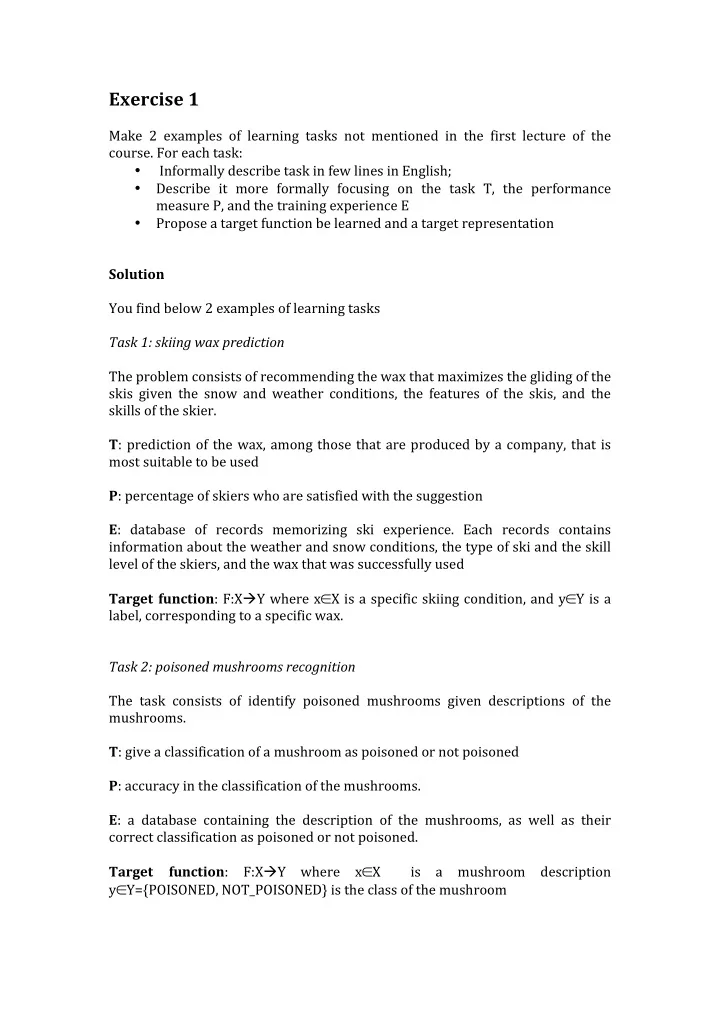

Exercise ¡1 ¡ ¡ Make ¡ 2 ¡ examples ¡ of ¡ learning ¡ tasks ¡ not ¡ mentioned ¡ in ¡ the ¡ first ¡ lecture ¡ of ¡ the ¡ course. ¡For ¡each ¡task: ¡ • ¡Informally ¡describe ¡task ¡in ¡few ¡lines ¡in ¡English; ¡ • Describe ¡ it ¡ more ¡ formally ¡ focusing ¡ on ¡ the ¡ task ¡ T, ¡ the ¡ performance ¡ measure ¡P, ¡and ¡the ¡training ¡experience ¡E ¡ • Propose ¡a ¡target ¡function ¡be ¡learned ¡and ¡a ¡target ¡representation ¡ ¡ ¡ Solution ¡ ¡ You ¡find ¡below ¡2 ¡examples ¡of ¡learning ¡tasks ¡ ¡ Task ¡1: ¡skiing ¡wax ¡prediction ¡ ¡ The ¡problem ¡consists ¡of ¡recommending ¡the ¡wax ¡that ¡maximizes ¡the ¡gliding ¡of ¡the ¡ skis ¡ given ¡ the ¡ snow ¡ and ¡ weather ¡ conditions, ¡ the ¡ features ¡ of ¡ the ¡ skis, ¡ and ¡ the ¡ skills ¡of ¡the ¡skier. ¡ ¡ T : ¡prediction ¡of ¡the ¡wax, ¡among ¡those ¡that ¡are ¡produced ¡by ¡a ¡company, ¡that ¡is ¡ most ¡suitable ¡to ¡be ¡used ¡ ¡ P : ¡percentage ¡of ¡skiers ¡who ¡are ¡satisfied ¡with ¡the ¡suggestion ¡ ¡ E : ¡ database ¡ of ¡ records ¡ memorizing ¡ ski ¡ experience. ¡ Each ¡ records ¡ contains ¡ information ¡about ¡the ¡weather ¡and ¡snow ¡conditions, ¡the ¡type ¡of ¡ski ¡and ¡the ¡skill ¡ level ¡of ¡the ¡skiers, ¡and ¡the ¡wax ¡that ¡was ¡successfully ¡used ¡ ¡ ¡ Target ¡function : ¡F:X à Y ¡where ¡x ∈ X ¡is ¡a ¡specific ¡skiing ¡condition, ¡and ¡y ∈ Y ¡is ¡a ¡ label, ¡corresponding ¡to ¡a ¡specific ¡wax. ¡ ¡ ¡ Task ¡2: ¡poisoned ¡mushrooms ¡recognition ¡ ¡ The ¡ task ¡ consists ¡ of ¡ identify ¡ poisoned ¡ mushrooms ¡ given ¡ descriptions ¡ of ¡ the ¡ mushrooms. ¡ ¡ T : ¡give ¡a ¡classification ¡of ¡a ¡mushroom ¡as ¡poisoned ¡or ¡not ¡poisoned ¡ ¡ P : ¡accuracy ¡in ¡the ¡classification ¡of ¡the ¡mushrooms. ¡ ¡ E : ¡ a ¡ database ¡ containing ¡ the ¡ description ¡ of ¡ the ¡ mushrooms, ¡ as ¡ well ¡ as ¡ their ¡ correct ¡classification ¡as ¡poisoned ¡or ¡not ¡poisoned. ¡ ¡ Target ¡ function : ¡ F:X à Y ¡ where ¡ x ∈ X ¡ ¡ is ¡ a ¡ mushroom ¡ description ¡ y ∈ Y={POISONED, ¡NOT_POISONED} ¡is ¡the ¡class ¡of ¡the ¡mushroom ¡ ¡
Exercise ¡2 ¡ ¡ Suppose ¡that ¡A 1 , ¡…, ¡A n , ¡C ¡are ¡random ¡variables. ¡Demonstrate ¡that ¡ • if ¡A 1 , ¡…, ¡A n ¡are ¡conditionally ¡independent ¡given ¡C ¡ • then ¡P(A 1 , ¡…, ¡A n |C) ¡= ¡P(A 1 |C) ¡* ¡... ¡* ¡P(A n |C) ¡ ¡ Hint: ¡demonstration ¡by ¡induction ¡ • inductive ¡base: ¡P(A 1, ¡A 2 |C) ¡= ¡P(A 1 |C) ¡* ¡P(A 2 |C) ¡ ¡ ¡ Solution ¡ ¡ 1. Inductive ¡base. ¡ ¡ We ¡demonstrate ¡that ¡if ¡2 ¡variables ¡A 1 ¡and ¡A 2 ¡are ¡conditionally ¡ ¡ independent ¡given ¡C ¡then ¡P(A 1 ,A 2 |C) ¡= ¡P(A 1 |C) ¡* ¡P(A 2 |C) ¡ ¡ ¡ ¡ P(A 1 ,A 2 |C) ¡= ¡P(A 1 |A 2 ,C) ¡* ¡P(A 2 |C) ¡= ¡ ¡ ¡ ¡ by ¡chain ¡rule ¡ ¡ = ¡P(A 1 |C) ¡* ¡P(A 2 |C) ¡ ¡ ¡ ¡ ¡ by ¡def. ¡of ¡cond. ¡indep. ¡ ¡ ¡ 2. Inductive ¡step. ¡ ¡ The ¡property ¡holds ¡for ¡n-‑1 ¡variables: ¡ ¡ P(A 1 , ¡…, ¡A n-‑1 |C) ¡= ¡P(A 1 |C) ¡* ¡... ¡* ¡P(A n-‑1 |C) ¡ ¡ 3. We ¡prove ¡the ¡property ¡for ¡n ¡variables ¡ ¡ P(A 1 , ¡…, ¡A n |C) ¡= ¡P(A 1 , ¡…, ¡A n-‑1 |A n , ¡C) ¡* ¡P(A n |C) ¡= ¡ by ¡chain ¡rule ¡ ¡ = ¡P(A 1 , ¡…, ¡A n-‑1 |C) ¡* ¡P(A n |C) ¡= ¡ ¡ ¡ by ¡def. ¡of ¡cond. ¡indep. ¡ ¡ = ¡P(A 1 |C) ¡* ¡... ¡* ¡P(A n |C) ¡ ¡ ¡ ¡ ¡ ¡ Q.E.D. ¡ ¡ ¡
Exercise ¡3 ¡ ¡ Write ¡a ¡small ¡program ¡in ¡Java ¡that ¡calculate ¡the ¡maximum ¡likelihood ¡hypothesis ¡ h ML ¡of ¡the ¡“tennis ¡problem” ¡when ¡ • The ¡available ¡data ¡is ¡the ¡table ¡on ¡page ¡8 ¡(up) ¡of ¡lecture ¡2 ¡ • The ¡dataset ¡X ¡is ¡the ¡set ¡of ¡sunny ¡days ¡with ¡weak ¡wind ¡ ¡ Solution ¡ ¡ Writing ¡a ¡Java ¡program ¡for ¡this ¡task ¡is ¡quite ¡simple. ¡You ¡can, ¡for ¡example, ¡store ¡ the ¡available ¡data ¡in ¡a ¡file. ¡Your ¡program ¡could ¡read ¡the ¡file ¡and ¡store ¡the ¡data ¡in ¡ memory. ¡Then, ¡the ¡program ¡could ¡take ¡a ¡weather ¡condition ¡(e.g. ¡outlook=sunny, ¡ wind=weak) ¡ as ¡ input ¡ and ¡ calculate ¡ the ¡ probability ¡ of ¡ the ¡ two ¡ hypotheses ¡ (classes). ¡Finally ¡the ¡program ¡could ¡return ¡the ¡maximum ¡likelihood ¡hypothesis. ¡
Recommend
More recommend